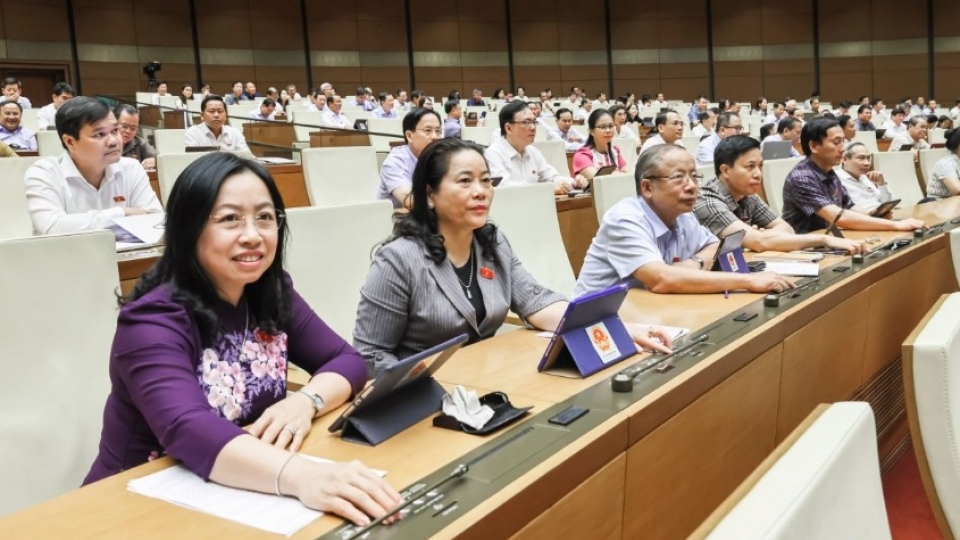Toward a 100-year vision: Vietnam reshapes its governance for better future
VOV.VN - Vietnam is gradually realising its 100-year vision with the goal of becoming a developed, high-income country, and one of the first steps in this journey is the reform of the state administrative apparatus, in the expectation that the new system will operate more efficiently and better serve the people.
The country is at a historic crossroads. The sweeping, methodical, and determined reform of its governmental structure is not only a clear reflection of the Party’s commitment to renewing its leadership approach for the modern era, but also signals the dawn of a new chapter defined by national happiness, prosperity, and strength.
Top-down approach – institutional breakthrough, nationwide consensus

At a historic session, the 15th National Assembly on June 12 passed a resolution to adjust administrative boundaries, officially reorganising the country into 34 provinces and centrally governed cities. This move is just the first in a series of comprehensive reforms that will establish a more efficient, dynamic, and citizen-oriented national governance model.
In a record short period of just seven months, the entire political system, from the central to grassroots levels, has mobilised simultaneously to implement hundreds of tasks with unprecedented urgency and determination. By July 1, 2025, the entire nation will officially operate under this new governance model.
What makes this reform particularly notable is its top-down approach. The Party takes the lead in initiating the reorganisation, followed by the Government and National Assembly. Conclusion No. 09-KL/BCĐ, issued by the Politburo on November 24, 2024, has laid out clear directions for restructuring the entire political system.
Widespread consensus within the Party and throughout society has been a decisive factor in the initial success. From senior leaders to local officials, and from central to local agencies, unified understanding has translated into resolute and synchronised action. Public support, in particular, has been key to turning reform plans into reality.
Streamlining for effectiveness – a new administrative architecture
This reform is not just about trimming staff or cutting intermediate levels. Reducing the number of provinces from 63 to 34, eliminating over 6,700 communes, and cutting nearly 130,000 public-sector positions reflects a fundamental rethinking of the administrative system to make it more streamlined, functional, and cost-effective.
It is a strategic turning point aimed at removing inefficiencies, overlaps, and fragmentation, and creating a governance framework that promotes digital transformation and sustainable development.
The restructured administrative map opens up a bold new vision for national development. Among the 34 provinces and cities, 21 have coastlines, enabling Vietnam to reach outward to over one million square kilometers of maritime territory, an affirmation of the country’s strategic ambition to become a strong maritime economy.
Local governments now have broader space and greater autonomy to plan for development, unleashing their potential and strengths. Thousands of functions and budgets will be decentralised to local levels, encouraging greater initiative, flexibility, and accountability in governance.
Overcoming inertia: reform for long-term growth

This is not a reform limited to one political term. It is the culmination of years of preparation and vision, first outlined in Party Central Committee Resolution 18-NQ/TW dated October 25, 2017. Achieving reform targets five years ahead of schedule underscores the effectiveness of the implementation phase.
The real test lies in operationalising the new model. Some disruptions are to be expected; some public unease is understandable. But if cadres and officials prioritise national interests over personal or local concerns, the new system will gradually run more smoothly and effectively.
The reform has involved silent sacrifices from tens of thousands of officials who stepped down or were reassigned during the restructuring. Many have set aside personal gain in favour of the greater good. Their selflessness and dedication, from the grassroots to the central level, are vital to ensuring the new system functions well.
These individuals, quietly forging ahead, are the backbone of a successful transformation that is crucial for turning the dream of a powerful, modern Vietnam into reality.
This is a true revolution in how Vietnam is governed, from institutions and structures to personnel and operations. More importantly, it is the first step toward building a modern, transparent, and citizen-centred public administration.
An efficient public sector will serve as the launchpad for realising Vietnam’s century-long vision to stand shoulder to shoulder with developed nations in the 21st century. And with national consensus and political will, this historic reform will surely become a milestone to remember.





